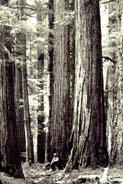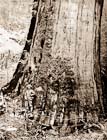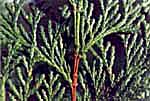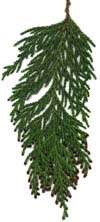
"A magnificent stand of mixed Port Orford white cedar and fir timber located in Curry County, Oregon, on the property of the C.A. Smith Timber Company. A fair example of the mixture of fir and cedar growth on Curry County lands" (American Lumberman 1911).

Chamaecyparis formosensis, thought to be the largest tree ever recorded, described by Carder (1995). The photograph, from Clinton-Baker (1913), is credited to Mr. A.R. Firth.

Foliage detail and transition from 1-yr to 2-yr old foliage on a Ch. obtusa in the Seattle arboretum. Twig diameter 2 mm [C.J. Earle].

Foliage from an ornamental Ch. pisifera, Seattle (USA) [C.J. Earle, 1999.03].

Chamaecyparis
Spach 1841
Common names
Cypress (Rushforth 1987, Welch and Haddow 1993), white-cedar, false-cypress, faux-cypres (Michener 1993).
Taxonomic notes
A genus generally regarded as comprised of 6 species:
Some authors include all species of Chamaecyparis in the genus Cupressus (Michener 1993), but molecular studies indicate they are not particularly closely related (Brunsfeld et al. 1994, Gadek and Quinn 1993, Mao et al. 2010). Two species sometimes included in this genus, Ch. funebris and Ch. nootkatensis, are here assigned to Cupressus and Callitropsis, respectively (Rushforth 1987, Welch 1991, Farjon 1998, Gadek et al. 2000, Mao et al. 2010) on the basis of various lines of evidence. Ch. hodginsii was formerly assigned to the monotypic genus Fokienia, but both morphological and molecular studies have firmly established it as nested within Chamaecyparis. Two other taxa sometimes treated as species (Ch. henryae and Ch. taiwanensis) are usually treated as subspecies or varieties of Ch. thyoides and Ch. obtusa respectively. Cultivated juvenile forms of several species have been referred to the superfluous Retinospora Sieb. & Zucc. The most recent molecular analysis of the genus, using both nuclear and plastid DNA evidence, finds it to have arisen prior to the Cretaceous-Tertiary boundary, with the most divergent species, C. thyoides, diverging at about that time. Next diverging is C. hodginsii, a time estimate also supported by fossil evidence. The remaining taxa have earliest common ancestors in Eocene time, with C. formosensis sister to C. pisifera, and C. lawsoniana sister to C. obtusa; post-Eocene changes in global climate have restricted the genus to its current temperate-to-subtropical distribution in Asia and North America (Wang et al. 2022).
Description
Tall monoecious trees (rarely shrubs) of pyramidal habit, the bark smooth, peeling off in strips or scales or fissured into ridges. Leading shoots nodding, branches spreading, the branchlets dorsiventrally flattened, rarely (Ch. thyoides) more or less terete or rhombic in cross section, in fan-shaped or pinnately flattened sprays. Leaves opposite in 4 ranks. Juvenile leaves subulate. Mature leaves opposite, scale-like, lateral and facial pairs of differing shape, similar in size or the facial pairs smaller, and closely overlapping, ovate to rhombic, acuminate to obtuse, entire. Staminate cones ovoid to oblong, yellow or (usually) red, stamens decussate, with 2-3 pairs of sporophylls, each sporophyll with 2-4 pollen sacs. Ovulate cones maturing and opening in 6-8 months from pollination, shed soon after seed release, globose to ovoid-globose, green or violet, often glaucous, maturing brown, 4-12(-14) mm; scales persistent, (2-)3-5(-6) pairs, peltate or basifixed, thick and woody, the terminal pair fused. Seeds (1)2-4(5) per scale, slightly compressed, with 2 equal, membranaceous wings. Cotyledons 2, rarely 3. x = 11 (Li 1975, Michener 1993, Walker 1976).
Distribution and Ecology
North America, Japan and Taiwan (Li 1975).
Remarkable Specimens
Chamaecyparis formosensis has the largest individuals. Ages to 1,755 years are reliably reported for C. lawsoniana. C. formosensis likely also achieves great ages, but I haven't seen documentation for it.
Ethnobotany
The genus is of immense importance to modern horticulture; two species (Ch. lawsoniana, Ch. pisifera) account for perhaps 80-90% of the ornamental conifers grown in British gardens.
Observations
See the various species.
Remarks
The name Chamaecyparis is derived from the Greek: chamai = on the ground, and kyparissos = cypress (Walker 1976).
Several of the species show high variation in seedbeds, leading to the selection for horticultural use of many hundred cultivars. "Three [Ch. lawsoniana, Ch. pisifera, Ch. obtusa] are very variable and have given rise to a ridiculous flood of selected seedlings and mutations, many of which are so similar to others as to be just not worth perpetuating. Unfortunately this flow still continues. Very great restraint should now be exercised in introducing fresh forms that will add more names to our listings but no more beauty to our gardens" (Welch and Haddow 1993). This exasperated remark is followed by a 57 page list of Chamaecyparis cultivar names, including 29 pages with 559 names in Ch. lawsoniana alone - no wonder!
Citations
American Lumberman. 1911.11.11. "The Realization of a Great Commercial Dream." American Lumberman n.v. (November 11, 1911):43-142.
Clinton-Baker, H. 1913. Illustrations of Conifers, Vol. 3. Privately printed: Hertford. Available at openlibrary.org.
Wang, Yi, Markus Ruhsam, Richard Milne, Sean W. Graham, Jialiang Li, Tongzhou Tao, Yujiao Zhang, and Kangshan Mao. 2022. Incomplete lineage sorting and local extinction shaped the complex evolutionary history of the Paleogene relict conifer genus, Chamaecyparis (Cupressaceae). Molecular Phylogenetics and Evolution 172:107485. doi.org/10.1016/j.ympev.2022.107485.
Welch, H.J. 1991. The Conifer Manual vol. 1.
Welch, H.J. and G. Haddow 1993. The World Checklist of Conifers.
This page co-edited with M.P. Frankis, 1999.02.
See also
Farjon (2005).



